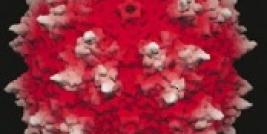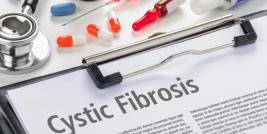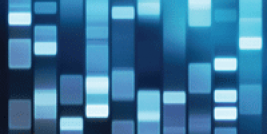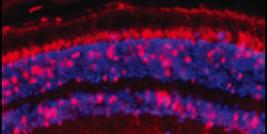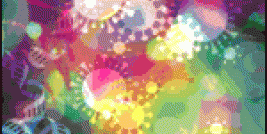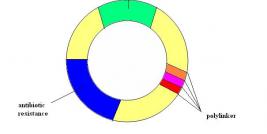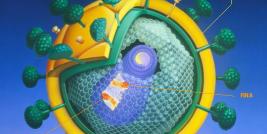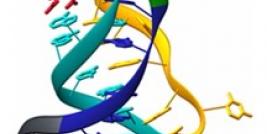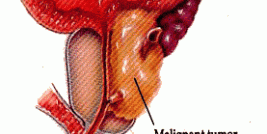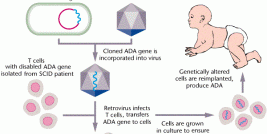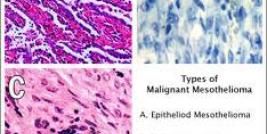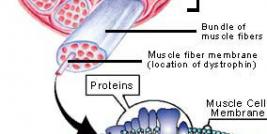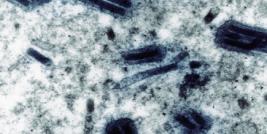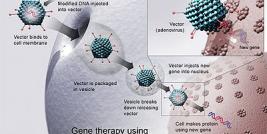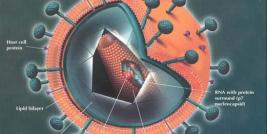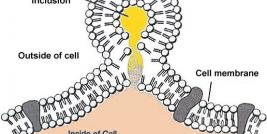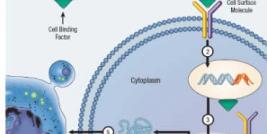Introduction:
Adenoviruses were first developed as expression vectors by Dr. Frank Graham and his colleagues at McMaster University. Microbix collaborates extensively with Dr. Graham, who provides access to the leading edge of Ad vector production technology and vector design. They have developed recombinant adenoviruses for gene delivery and vaccine purposes for many years, and benefit from access to technologies such as Dr. Graham's popular AdMax™ Cre-lox/FLP-frt based system for rapid, high-efficiency Ad vector construction
Technologies:
1. AdMax
Transgenes are cloned into a small high copy number shuttle plasmid, which is then cotransfected with an Ad genomic plasmid (see diagram) into 293 cells. High efficiency site specific recombination catalyzed by Cre or FLP recombinase results in "rescue" of the expression cassette into the left end of an E1 deleted (first generation) Ad vector.
Recombination in cotransfected cells introduces the gene of interest into infectious Ad DNA while simultaneously excising the recombinase gene.
2. AdMax Hi-IQ
It is possible to enhance expression of proteins cloned in Ad vectors by introducing an intron between the transcription start and the translation start of the protein. However, extreme levels of transgene expression can then have inhibitory effects on virus replication, even with proteins that are not cytotoxic when expressed at moderate levels. Even mild inhibition of virus replication can significantly reduce the efficiency or even totally prevent rescue of vectors.
Inhibition of protein expression, even if only partial, can significantly improve the rescue efficiency of cassettes containing a cDNA expressed from a promoter-intron combination. Microbix have developed a cell line that express the lac repressor, and expression cassettes that contain the lac operator (repressor binding sequence) such that transcription from the cassette is inhibited when the vector is rescued or propagated in host cells that express the repressor but is unimpeded in all other cells.
This "Hi-IQ" system has been combined with the AdMax™ two plasmid vector rescue system for isolation of vectors expressing all but the most toxic proteins at ultra high levels (see Figure). The system differs from the original AdMax™ only in its use of 293 cells expressing lac repressor (293-IQ cells) and shuttle plasmids containing expression cassettes with the MCMV IE gene promoter, an intron, and a lac operator sequence for down regulation of expression. The vectors are rescued and propagated in 293-IQ cells and the transgene can then be expressed by transduction of any other cell type where transcription is relieved of repression.
3. Helper-Dependent Adenovirus
One of the major drawbacks of replication incompetent adenoviruses (also commonly referred to as "First Generation" adenoviruses) is that the deletion of the E1 gene is not enough to totally obliterate all viral gene activation. "Leaky" viral gene expression from the vector itself results in the generation of anti-Ad cytotoxic T-lymphocytes. This kind of immune response not only impacts the duration of transgene expression in vivo but it also results in significant acute inflammatory reactions in the host.
Eliminating more of the viral genome can serve to reduce Ad-induced toxicity induced from this low level viral (early and late) gene expression. However, aside from removal of the E3 gene which is dispensable to growth, further deletions of viral genes relies on the supplementation of those viral gene products via the complementing cell line. While this does serve to improve on the longevity of transgene expression, the development of such continuous complementing cell lines is time consuming and difficult.
Helper dependent (HD) adenovectors have incurred deletion of all viral genes. They contain only the cis-acting elements. This encompasses the left and right ITR sequences (critical for DNA replication) as well as the packaging region (required for encapsidation of the vector genome). This amounts to retaining ~600bp of the adenoviral genome. The remaining intervening section is filled with non-coding "stuffer DNA". Such elimination of viral DNA ensures that no viral genes are present for expression from the HD backbone itself, hence offering the potential for reduced toxicity and prolonged transgene expression. In addition, it also allows for greatly increased cloning capacity of such vectors to ~37 kb. This is an important factor since the cloning capacity can be a significant limitation for many other delivery systems. Being devoid of all viral genes, HD vectors have an absolute requirement for all viral gene products (aside from E3) for their propagation. These gene products can be supplied in trans most conveniently via a "Helper virus".
A Helper virus is essentially a first generation virus with the capacity to dominate over the HD vector in tissue culture propagation. Therefore it is critical to incorporate a system which will incapacitate the Helper virus to allow the HD virus to become the dominant viral population. The Cre/loxP system is one method that can achieve this goal. This system entails two components. One is the incorporation of the loxP sites which flank the packaging signal of the Helper virus. The second is the development of Cre recombinase transformed 293 cell line (293Cre4). The use of both components allow for the initial growth of the Helper viral DNA to replicate and provide the necessary viral gene products in trans for propagation of the co-infected recombinant HD (rHD) vector. The Cre recombinase supplied by the 293Cre4 cells line then acts to excise the packaging signal through recombination between the flanking loxP sites, rendering the helper genome unpackageable.
The HD genome, on the other hand is unaffected by the Cre recombinase and is free to be packaged into the preformed capsids. The titre of the HD vector is increased by serial coinfection of 293cre4 cells with the HD vector and the Helper virus. Following sufficient level of expansion of the rHD virus, the final step requires CsCl ultracentrifugation for purification.
4. AdCRE
There are numerous systems for regulating gene expression, and many have been used in Ad vectors. However, most (if not all) of these are leaky, and allow at least a low level of expression from cassettes in the "off" mode. As a consequence certain cytotoxic genes cannot be rescued into Ad vectors. Furthermore, even gene products that are not necessarily cytotoxic can be inhibitory when over expressed and may result in the cassette being difficult or impossible to rescue into an Ad vector. In order to circumvent this problem Microbix have developed an adenoviral system where expression of the reporter gene is switched on by infecting a host cell that expresses the Cre recombinase or by coinfection of cells with a second Ad vector that expresses Cre. In this system a spacer region, flanked by two loxP sites, is inserted directly in front of the reporter gene. Expression of CRE then results in the excision of the spacer region and the reporter gene is turned on (see diagram below):
First generation (FG) Ad vectors expressing Cre recombinase have all the advantages of Ad vectors, namely growth to high titres, ease of purification, efficient gene transfer resulting in high level gene expression in virtually any mammalian cell type and efficient gene delivery to a variety of different tissues when injected into animals. The transient nature of gene expression from FG Ad vectors is also advantageous for most applications using Cre.
Because Ad vectors can be used for efficient gene delivery into many tissues in most animals the use of AdCre in vivo makes possible an entirely new approach to using transgenic animals in research: "somagenics" in which delivery and expression of recombinases can be used to remodel the genome in somatic tissues of transgenics carrying floxed DNA.
5. NautCell
Adeno-associated virus vectors (rAAV) are emerging as the preferred vectors for gene therapy and gene transfer purposes because of established safety records, high transduction efficiency, and the level and stability of expression in a wide spectrum of cells and tissues. Until now, the yield of infectious rAAV has been a limiting factor in the widespread acceptance of this vector system, since yields are consistently two orders of magnitude lower than wildtype AAV. Consequently, use of rAAV was limited by the difficulty in obtaining high titre vector stocks.
To address this problem, Nautilus Biotech (Paris, France www.nautilusbiotech.com) has generated NautCellTM™, a reliable and traceable 293 HEK cell clone producing higher titre AAV vectors.
NautCellTM™ allows the production of about one order of magnitude more infectious units (IU) without changing the number of genome-containing virus particles (VP). This cloned cell line is ideal for further development of pharmaceutical products based on AAV vector technology because it is scalable and produces the higher yield of nfectious progeny virus.
Vector maps and sequences for microbix products can be found at:
http://www.microbix.com/Public/Default.aspx?I=65&n=Maps+and+Sequences

